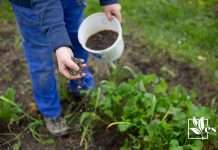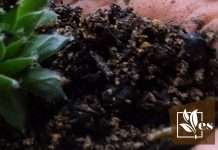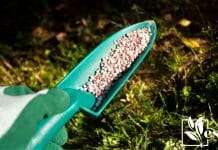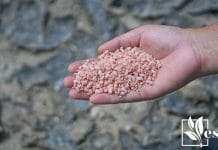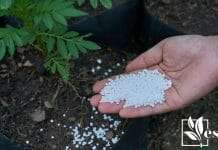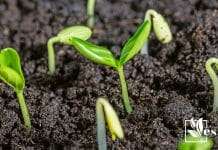Wood chips vs mulch has been a hotly-debated topic among hobbyists because both of these additives offer something good to the garden.
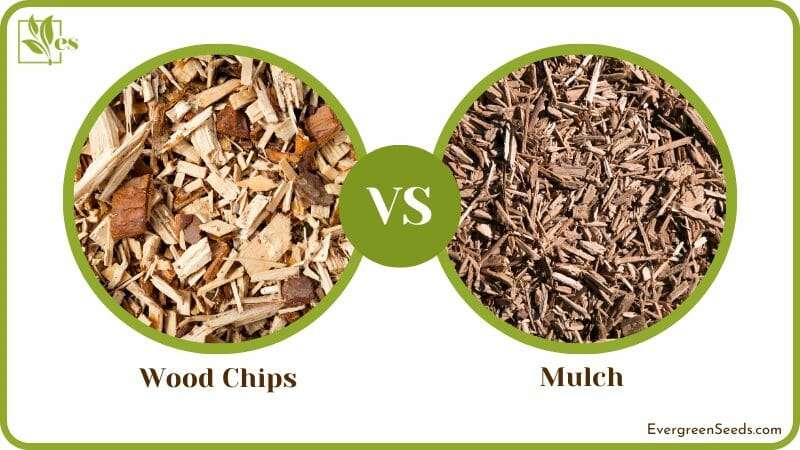
If you find yourself wondering which is which and what your garden needs, then this article is a one-stop reservoir of all the information that you need for differentiating wood chips from mulch. You will also learn how these two relate to each other, as well as what they are good for.
JUMP TO TOPIC
Comparison Table
Here is a quick overview of the difference between wood chips and mulch.
| Features | Wood Chips | Mulch |
| Bulkiness | Bulkier | Lighter |
| Water retention | Lower water retention | Better water retention |
| Preparation | Made from interior parts of trees | Made from bark chips |
| Variety | Only have one source, which is the interior of trees | Different types exist, depending on the material used. Other variations include hay, grass and leaves. |
| Texture | Softer | Tougher |
| Uses | Best for perennials, shrubs and trees | More ideal for gardening |
Mulch vs Wood Chips
The main difference between wood chips and mulch is that wood chips are always made from the interior of trees, while mulch can be made from different materials including wood bark. The texture of wood chips is also softer than that of mulch.
– Shredded Mulch or Wood Chips?
One of the major differences between shredded mulch and wood chips is that wood chips are natural products of nature while shredded wood mulch is more synthetic. However, it is still possible for shredded wood mulch to contain organic substances.
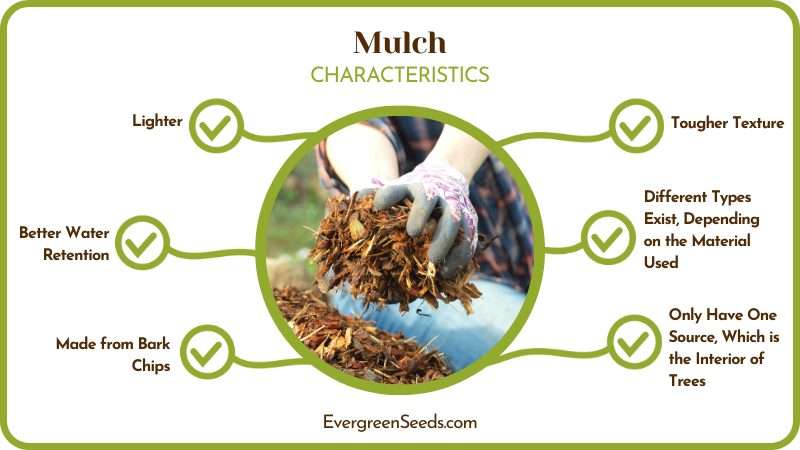
Shredded wood mulch is usually created as byproducts in the processing of wood products such as lumber and paper. As we mentioned earlier, wood chips are obtained when the interior of trees is shredded.
– Texture
The texture of the shredded mulch and wood chips is notably different. The chunks that make up wood chips are much bigger than those of shredded mulch. As a matter of fact, the size of chunks of wood chips is approximately four inches long and three inches wide. The chunks of shredded wood mulch have an approximate length of two inches and a width of 1.5 inches.
The bigger size of the wood chip chunks contributes to their ability to absorb more moisture. The shredded mulch will therefore take in less water because of the smaller chunk size. Again, the shredded wood mulch decomposes at a faster rate than the wood chips.
– Possible Toxicity
Since shredded wood is made as a byproduct of some industrial processes, it may contain some chemicals. Not all chemicals that are used in the industry are safe for plants and animals.
Dyed wood, for example, may have chemicals that are toxic if they gain entrance into animals and plants. Therefore, if the shredded mulch prepared from such wood is used in flower beds, the harmful chemical compounds might negatively affect plants, even causing death.
Wood chips are much safer as they are unlikely to have other external chemicals within them. In fact, wood chips have remarkable chemical diversity, which makes them a great nutritional source for your plants. Based on that, wood chips are very suitable for gardening.
What Is Mulch Best For?
The best thing that mulch is good for is that it is able to retain moisture while contributing to the nutritional quality of your plant’s soil. Continue reading for more information about the benefits of this type of ground cover in this section.
– Water Retention
As you choose the material for covering the ground in your garden, consider your reasoning for doing that. If you are covering the ground for water retention, then mulch would be a better option than wood chips.
This is because mulch gives a smoother coverage so less ground will be exposed to the sun. The lesser the ground is exposed to the sun and air, the lower the rate at which water evaporates from the ground. The roots of your plant are better protected when you use mulch.
It is unfortunate that the texture of mulch makes it unsuitable for areas that experience heavy downpours that cause floods. The material demonstrates a high ability to retain moisture, so it can promote waterlogging conditions for your plants. The water-retaining abilities of mulch are a plus in situations where you want to conserve the moisture in the soil of your plant.
– Durability
Wood bark mulch can stick around for approximately 10 years, which is quite longer than the five-year duration of wood chips. The bark mulch is more appropriate when you want a cover that will stay in position for longer. Wood chips are more likely to slip and expose your soil. Moreover, if they stay for too long, wood chips can end up producing toxic substances that may potentially kill your plants.
– Weed Control
If you add the bark in flower beds, the mulch will reduce the amount of sunlight that will reach the weeds. This strategy has the positive effect of reducing the growth of weeds.
– Nutritional Value Addition
The bark mulch also contributes significantly to the nutritional value of the soil under it. More interestingly, bark even decomposes faster than the wood chips, thereby making the soil richer.
– Uses
Mulch is ideal for gardening purposes. We recommend that you use mulch when you are growing more robust plants and even trees.
– Mulch: The Satellite View
In technical terms, mulch refers to anything that can be placed to cover the surface of the soil on which plants are grown. So the plants will be protruding through the mulch, while the latter covers the rest of the ground.
Reasons for adding mulch include reducing water evaporation from the soil, regulating soil temperatures, stabilizing soil moisture, as well as controlling weeds. Mulching can also come in handy in maintaining a good soil structure, considering that it prevents soil erosion and compaction.
Mulch can be organic or inorganic. However, the former is the most common type that is preferred by most professional plant caregivers. Organic mulch can come in the form of compost, shredded hardwood material, wood chips, pecan shells, straw, leaves, pine needles, hay, and coffee grounds. Some examples of inorganic forms of mulch include pebbles, rubber gravel, plastic sheeting, and crushed stone.
What Are Wood Chips Best For?
Wood chips are best for increasing carbon in the soil, which can transfer to your plant and lead to better plant growth and respiration. This section outlines some of the interesting benefits of wood chips.
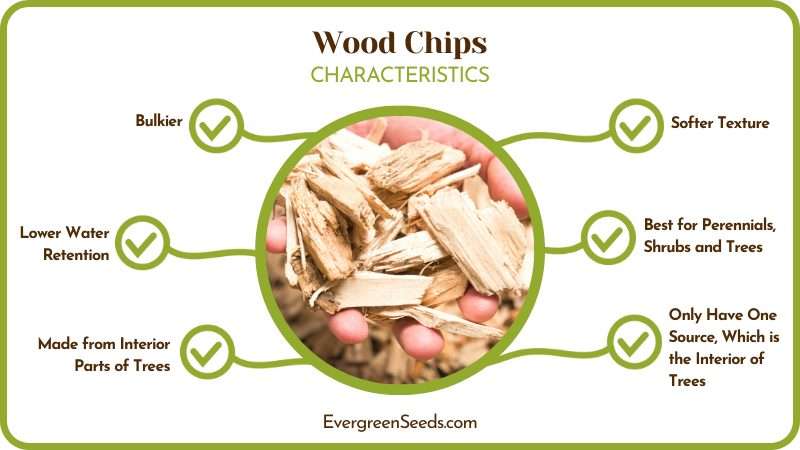
– Neater Ground Cover
Wood chips are relatively bulkier than mulch. By virtue of them having this characteristic, the wood chips make a cover that appears neater than the one that is made from mulch.
– Texture
If you are looking for a denser and softer covering on the ground of your garden or flower bed, then wood chips have what it takes to provide you with that.
– Good Carbon Source
Wood chips are a great reservoir of carbon, which makes them suitable for topping the content of the element in your soil. If you want to achieve a more balanced carbon to nitrogen ratio in your garden soil, then go for mulch instead of wood chips.
– Other Uses
If you intend to grow perennials, shrubs and trees, wood chips would be the best option. Wood chips also come in handy if your aim is landscaping, considering that it helps to maintain the most state of the soil for longer in addition to reducing weed growth and improving the appearance of a landscape.
Wood chips appear uniform so you can use them on sidewalks and paths. They are also more appropriate for playgrounds. Adding wood chips is also a great way to control soil erosion.
– Wood Chips as a Form of Mulch
Now you have seen that wood chips can be used as a form of organic mulch. This means that there are many other applications for wood chips and mulching is just one of those. To make a mulch out of wood chips, large mulch chips or small ones are spread over the ground as desired.
Wood chips are effective as mulch especially when you are growing trees, small fruiting species, and shrubs. We recommend that you add about four inches of the wood chip mulch in a six-foot diameter around the base of your plant.
Generally, the amount of mulch and the size of the ground that should be covered depend on the size of your plant. The bigger the plant, the more mulch you will need and the greater the ground coverage.
– Advantages
Using wood chips as mulch comes with some advantages. For instance, in regions that receive excessive rainfall, the wood chip mulch can protect the ground from potential damage. The structure of the soil is maintained and chances of soil erosion are significantly reduced.
When you use wood chips to grow your small trees, their survival rates increase as they protect the roots of these plants. Wood chips also improve the organic content of the soil for your plant. They also increase the nutritional acumen for your soil.
– Disadvantages
Although there is a myriad of advantages that are associated with using wood chips, there are also some disadvantages that are associated with using them. One such downside is that if wood chips stay on the soil for extended periods of time, they might begin to produce some acids and other compounds that could affect the healthy growth of your plants.
Wood chips may also result in reduced aeration and oxygen circulation. This leads to anaerobic respiration, which is not what you want for the roots of your plant. In seasons that are warmer, using wood chips can lead to gaseous emissions that are potentially harmful to your plants.



